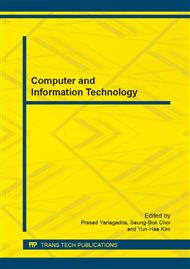[1]
D. J. C. MacKay. Good error-correcting codes based on verysparse matrices. IEEE Trans. Inform. Theory. vol. 45(1999), pp.399-431.
DOI: 10.1109/18.748992
Google Scholar
[2]
C. Berrou, A. Glavieux, and P. Thitimajshima. Near shannonlimit error-correcting coding and decoding: Turbo-codes(1). IEEE International Conference on In Communications. vol. 2(1993), pp.1064-1070.
DOI: 10.1109/icc.1993.397441
Google Scholar
[3]
R. G. Gallager. Low-Density Parity-Check Codes. Cambridge, MA:M.I.T. Press, (1963).
Google Scholar
[4]
T. J. Richardson, M. A. Shokrollahi, and R. L. Urbanke. Design ofcapacity-approaching irregular low-density parity-check codes. IEEETrans. Inform. Theory. vol. 47(2001), p.619–637.
DOI: 10.1109/18.910578
Google Scholar
[5]
Tao Tian, C. Jones, J. D. Villasenor, and R. D. Wesel. Selective avoidance of cycles in irregular LDPC code construction . IEEE Transactions Communication . vol. 52(2004), p.1242–1247.
DOI: 10.1109/tcomm.2004.833048
Google Scholar
[6]
S.J. Johnson, S. R. Weller. Constraining LDPC degree distributions for improved error floor performance. IEEE Communications Letters. vol. 10(2006), p.103–105.
DOI: 10.1109/lcomm.2006.02001.
Google Scholar
[7]
IEEE P802. 11nTM/D1. 02. Draft Amendment to STANDARD Information Technology Part 11: Wireless LAN Medium Access Control(MAC) and Physical Layer (PHY) specifications: Enhancements for Higher Throughput. IEEE 802. 11 document, July. (2006).
DOI: 10.1109/ieeestd.2009.5307322
Google Scholar
[8]
Y. Kou, S. Lin, M. P.C. Fossorier. Low-density parity-check codes based on finite geometries: a rediscovery and new results. IEEE Transactions on Information Theory. vol. 47( 2001).
DOI: 10.1109/18.959255
Google Scholar
[9]
Xiaoyu Hu, E. Eleftheriou, D. M. Arnold. Progressive edge-growth tanner graphs. IEEE Global Telecommunications Conference . Vol. 2(2001), pp.995-1001.
DOI: 10.1109/glocom.2001.965567
Google Scholar
[10]
G. Liva, W. E. Ryan. Short low-error-floor tanner codes with hamming nodes. IEEE Military Communications Conference. 2005, pp.208-213.
DOI: 10.1109/milcom.2005.1605687
Google Scholar


